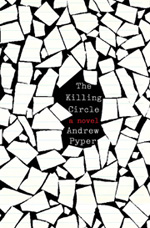The Killing Circle

As little attention as is paid to literature in the United States—apparently we have greater matters with which to deal—Canadian writers are rarely acknowledged (Alice Munro excepted) down here in the lower 48. Andrew Pyper has a good chance of breaking through the caribou curtain with his fourth novel, The Killing Circle, not the least of reasons is that his first novel, Lost Girls, has been optioned—as well the above-mentioned fourth novel. Add some appealing60-secondminiatures (formerly called advertisements) and one might predict some serious currency in the new-attention economy. And that’s before the merits of Pyper’s work is considered.
In this new opus, we are presented with widowed with young son, Patrick Rush, former National (read: Toronto) Star book critic reduced to wasting type on pop-culture television. Rush, having artistic ambitions, joins a writer’s group—in a flailing attempt to turn around his disenchanted and unproductive life. As his participation in this group (led by a bent literary figure, Conrad White) commences, a rash of murders become the second thread of this narrative. Pyper’s prose—bursts of sentences with less than three words—can be a little caricaturishly noir, but his sensibilities are acute:
There is an aggression in the streets now, the suggestion that comes with insatiable desires. Because there is more on offer now, there is more to want. This kind of change, happening as it’s happening here, fast and unmanageable, makes people see others in ways they hadn’t before. As a market. A demographic. Points of access.
As Rush’s artistic struggles are one of the main, if not the main, thrusts of The Killing Circle, his commentary operates on the meta-literary level—a character who is a writer describing all sorts of writerly matters and concerns. It’s not a bad approach to take, though I leave it to you to decide if some of his commentary is a bit obvious:
The dawning millennium, we were told, was ushering in a new breed of “user friendly” newspaper, one that could compete with the looming threats of the internet and cable news channels and widespread functional illiteracy. Readers had grown impatient. Words in too great a number only squandered their time. In response, the Arts section became the Entertainment section. Features were shrunk to make room for celebrity “news” and photos of movie stars walking, sunglassed, with a barbell-sized latte. Memos were circulated directing us to fashion our stories so as to no longer appeal to adults seeking information and analysis, but to adolescents with attention-deficit disorder.
Obvious. And sad. Indeed.
